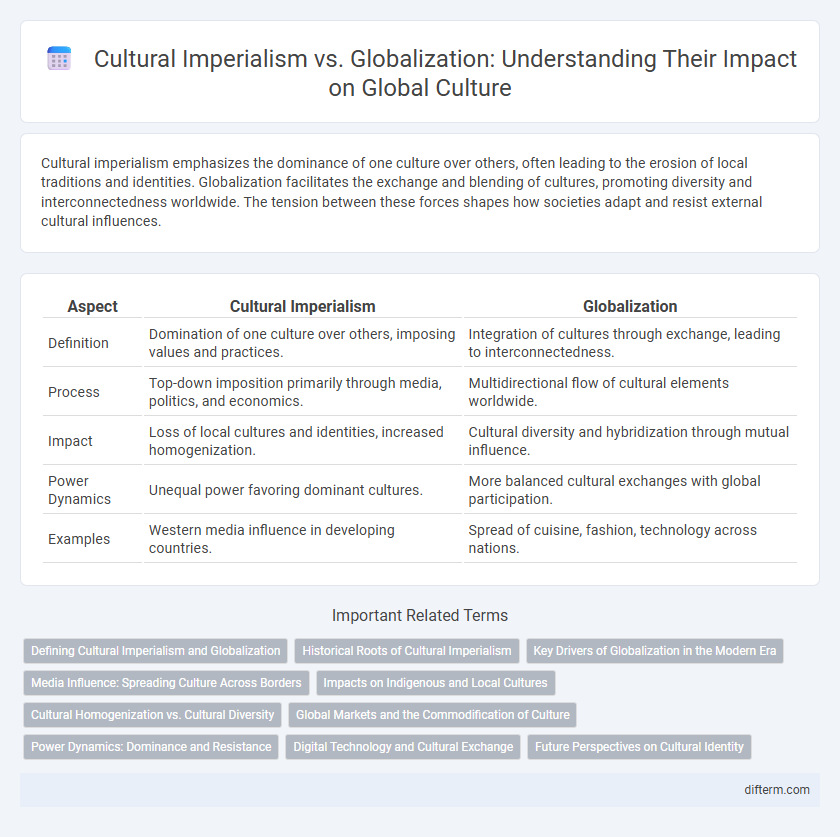Cultural imperialism emphasizes the dominance of one culture over others, often leading to the erosion of local traditions and identities. Globalization facilitates the exchange and blending of cultures, promoting diversity and interconnectedness worldwide. The tension between these forces shapes how societies adapt and resist external cultural influences.
Table of Comparison
| Aspect | Cultural Imperialism | Globalization |
|---|---|---|
| Definition | Domination of one culture over others, imposing values and practices. | Integration of cultures through exchange, leading to interconnectedness. |
| Process | Top-down imposition primarily through media, politics, and economics. | Multidirectional flow of cultural elements worldwide. |
| Impact | Loss of local cultures and identities, increased homogenization. | Cultural diversity and hybridization through mutual influence. |
| Power Dynamics | Unequal power favoring dominant cultures. | More balanced cultural exchanges with global participation. |
| Examples | Western media influence in developing countries. | Spread of cuisine, fashion, technology across nations. |
Defining Cultural Imperialism and Globalization
Cultural imperialism refers to the dominance of one culture over others, often through media, language, and consumer products, leading to the erosion of local traditions and identities. Globalization encompasses the increasing interconnectedness and exchange of cultures, ideas, and economic activities across the world, fostering both cultural hybridization and homogenization. Understanding these concepts reveals the tension between preserving cultural diversity and embracing global integration in contemporary society.
Historical Roots of Cultural Imperialism
Cultural imperialism has deep historical roots in colonialism and the expansion of European empires, where dominant powers imposed their language, religion, and customs on indigenous populations. These practices created lasting impacts on cultural identities and social structures worldwide, shaping global power dynamics that persist today. Understanding this history is crucial to analyzing the tensions between cultural imperialism and the phenomena of globalization.
Key Drivers of Globalization in the Modern Era
Technological advancements, especially in communication and transportation, serve as primary drivers of globalization by enabling rapid information exchange and cross-border interaction. Economic integration through multinational corporations and international trade agreements fosters interconnected markets and cultural exchange. Migration and global media further promote the diffusion of cultural values, often leading to tensions associated with cultural imperialism as dominant cultures influence local traditions.
Media Influence: Spreading Culture Across Borders
Media influence plays a crucial role in cultural imperialism by predominantly disseminating Western values and lifestyles, often overshadowing local traditions and identities. Through globalized media networks, cultural products such as films, music, and television programs cross borders rapidly, creating a homogenized cultural landscape that favors dominant cultures. This widespread media exposure shapes consumer behavior and cultural preferences worldwide, accelerating the process of cultural globalization while raising concerns about cultural erosion.
Impacts on Indigenous and Local Cultures
Cultural imperialism often results in the erosion of indigenous and local cultures by imposing dominant cultural values, languages, and practices, leading to loss of cultural identity and traditional knowledge. Globalization accelerates cultural exchange but can also homogenize diverse cultural expressions, threatening the survival of unique customs and languages. Preservation efforts and local empowerment initiatives are crucial to mitigate these impacts and promote cultural diversity in a globalized world.
Cultural Homogenization vs. Cultural Diversity
Cultural imperialism often leads to cultural homogenization, where dominant cultures overshadow and diminish local traditions, languages, and identities. Globalization, while promoting interconnectedness and exchange, risks eroding cultural diversity by spreading standardized values, media, and consumption patterns worldwide. Protecting cultural diversity requires conscious efforts to celebrate and preserve unique cultural expressions amid global economic and social integration.
Global Markets and the Commodification of Culture
Global markets drive the commodification of culture by turning unique cultural expressions into standardized products for mass consumption. This process often leads to the dilution of traditional practices and the dominance of global brands, reshaping cultural identities worldwide. The tension between preserving cultural diversity and maximizing economic profits illustrates the complex impact of globalization on cultural heritage.
Power Dynamics: Dominance and Resistance
Cultural imperialism manifests through dominant nations imposing their cultural values and media on less powerful societies, reinforcing asymmetrical power relations and eroding indigenous identities. Globalization facilitates intercultural exchange but often intensifies these dynamics by enabling transnational corporations and Western media to shape cultural consumption globally. Resistance emerges as marginalized groups reclaim and reinterpret cultural symbols, forging hybrid identities that challenge hegemonic narratives and assert local agency.
Digital Technology and Cultural Exchange
Digital technology accelerates cultural exchange by enabling instant communication and access to diverse cultural content worldwide. However, cultural imperialism persists as dominant cultures often control digital platforms, shaping global narratives and consumer preferences. This power imbalance challenges the genuine plurality of cultural expressions in the era of globalization.
Future Perspectives on Cultural Identity
Future perspectives on cultural identity emphasize the ongoing tension between cultural imperialism and globalization, where dominant cultures often overshadow local traditions yet also create opportunities for hybrid cultural expressions. Technological advancements and increased connectivity facilitate the exchange of cultural ideas, potentially fostering a more inclusive global culture while challenging the preservation of unique cultural identities. Strategic policies promoting cultural diversity and digital literacy are essential to balance global influence with the protection and revitalization of marginalized cultural heritages.
Cultural imperialism vs Globalization Infographic

 difterm.com
difterm.com